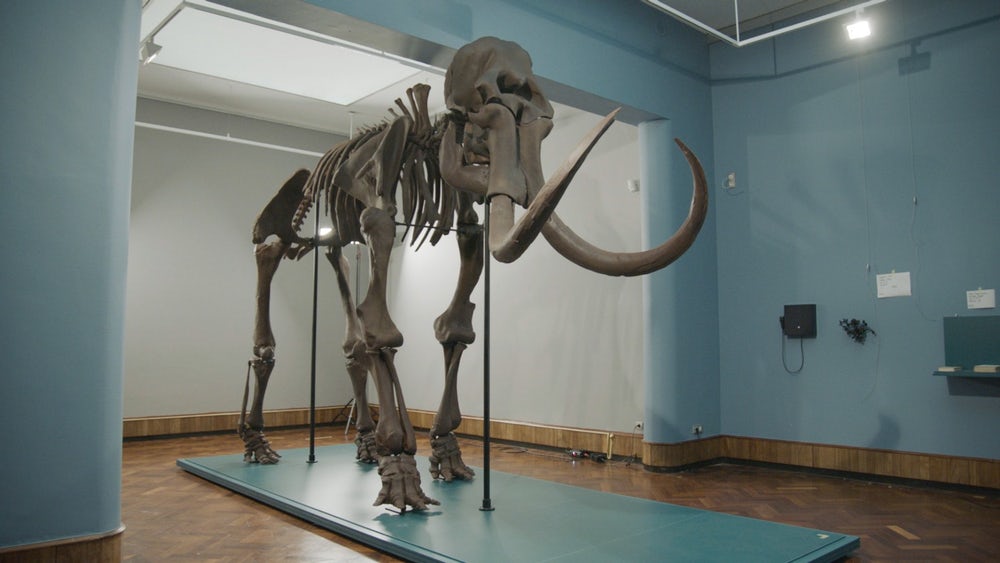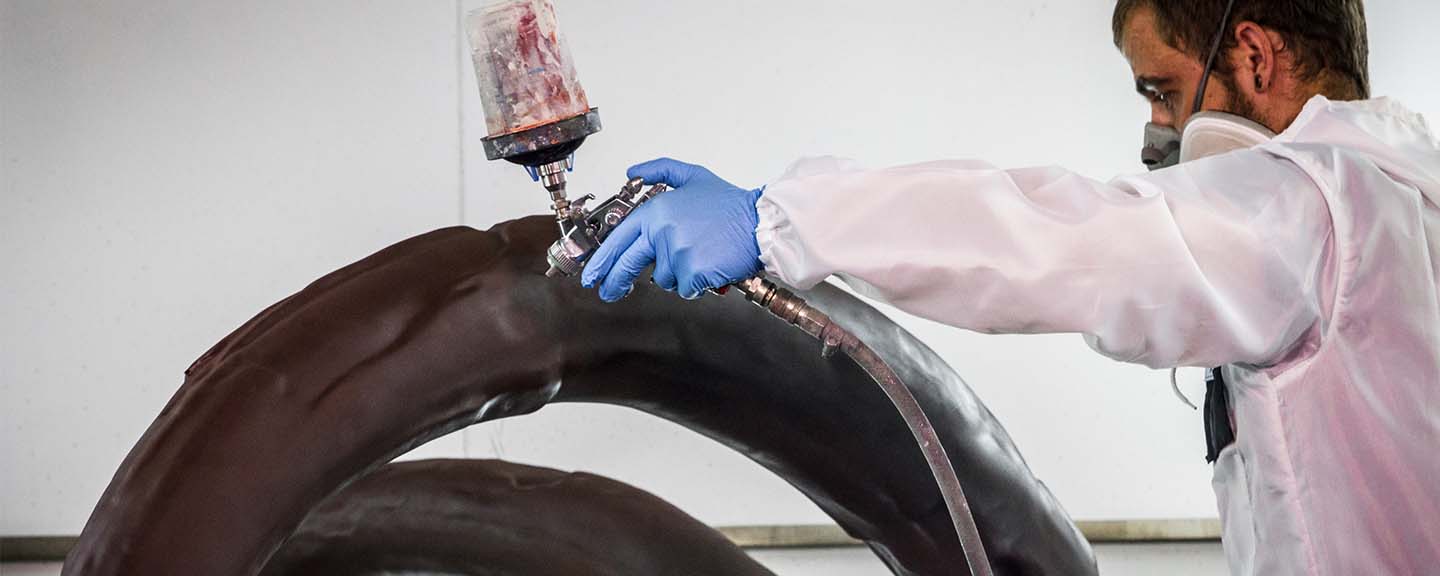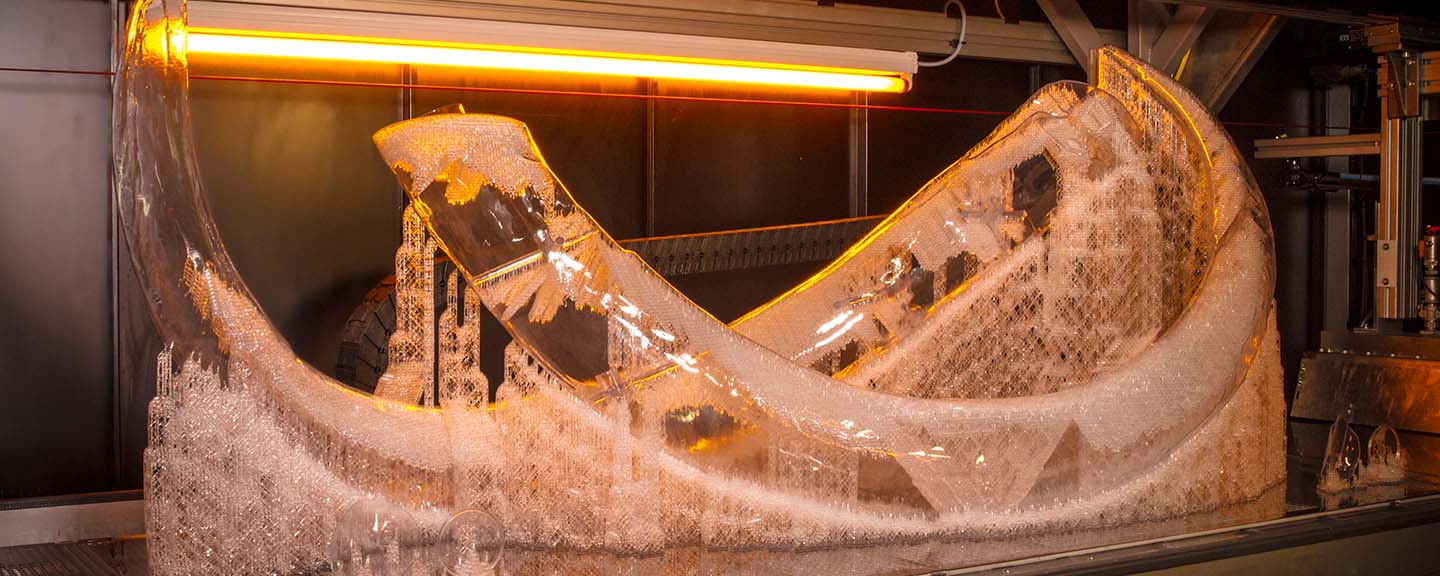The largest project in stereolithography: a 3D mammoth skeleton printed on a 3D printer

The Royal Belgian Institute of Natural Sciences in Brussels (RBINS), founded in 1846, employs more than 250 research scientists. There are 38 million exhibits here, including, since 1869, the Lyr mammoth is the first skeleton of its kind to be displayed to the public in Western Europe.
Discovered, as the name implies, near the town of Lear in the province of Antwerp, the skeleton still remains one of several fully preserved mammoth skeletons. Rare exhibit is extremely important for science, not to mention the fact that it attracts lovers of natural history from around the world. Thus, there was an excellent chance to make a gift to the city museum of Lear, timed to coincide with its re-opening. It is impossible to transfer the mammoth skeleton from Brussels, but you can recreate it!
A team dedicated to preserving the history of Lyra, led by local Kiwanis volunteers, turned to Materialize with the exciting idea: to use 3D printing to create an exact replica of the skeleton in full size. In other words, to apply modern technologies in order to return the prehistoric inhabitant of Lyra to their native lands. After 320 bones were printed in 1260 hours, the Lirm Mammoth 2.0 was born.
')

"Bones" are covered with several layers of paint of various shades and a protective layer of varnish
How to print a mammoth skeleton in full size?
When you want to reproduce an exact copy of the mammoth, it becomes clear: size matters. Recreating more than 300 bones, some of which are more than 2 meters long (more than an adult!), Is not an easy job. Taking into account the fragility and risk of damage to genuine bones, the project became a unique challenge.
“When the skeleton appeared in the museum in 1869, the innovative technology consisted in not having drilled or otherwise disrupting the integrity of the bones in order to show the mammoth in full size,” says the royal institute paleontologist Dr. Mitye Germonpre, who worked closely with Materialise in within the project. “Naturally, no one wanted to risk the natural integrity of the skeleton in this new endeavor.”
Similar creative thinking and technical solutions took place when creating a copy. Instead of using an external supporting structure, like a genuine Lyre mammoth, it was planned to create the most unobtrusive internal support that would really bring the model to life.
For the first time, stereolithographic printers, which we called Mammoth, were used in 2001. Thanks to the camera construction of 2100 x 700 x 800 mm, they are ideal for printing large objects in one session.
Gertyan Brynen, Project Manager
3D printing provides incredible freedom and accuracy of design, so the choice fell on this technology in a natural way. As Dr. Germonpre notes, “3D printing is increasingly becoming an extremely useful tool for paleontology. For example, we can study fossils without damaging precious authentic samples, and work on the same fossil in a virtual environment with colleagues from around the world. ” But how to print the bones in full size?

Printing on stereolithographic 3D-printer
Large format 3D printing in action
Stereolithographic 3D printers from Materialize were the adequate answer to this question. Project Manager Gertyan Brynen and a team of 19 people, including engineers, CAD and post-production specialists, as well as Institute experts, including Dr. Germonpre, were responsible for the work.
“For the first time, stereolithographic printers, which we called Mammoth (“ Mammoth ”), were used in 2001. Thanks to the camera construction of 2100 x 700 x 800 mm, they are ideal for printing large objects in a single session, says Brynin. “At that time, we thought about solving such tasks as printing prototype car dashboards, architectural models , large parts for industrial and production needs for individual orders. But the bones ... It was a new challenge that we accepted with pride and excitement. ”
Mammoth stereolithographic printers from Materialize at once apply a layer of UV-sensitive liquid photopolymer with a thickness of 1/10 mm, which is selectively hardened by a laser so as to exactly match the required design characteristics. To create special supports for the shape of bones and laser sintering of small bones (including the mammoth vertebrae) and connection points, nine 3D printers should work for a month. But before you start printing, it was necessary to fix the dimensional data and optimize them for 3D printing. “There was only two months left until the launch date,” adds Brynin, “and every step had to be carefully planned.”

A large-scale project brought together a team of 19 people, including engineers, decorators and artists, as well as a paleontologist
Skeleton Scanning and Invisible Support
The external supporting structure of the original skeleton allowed the museum to detach and scan each bone on the spot separately, transferring data to Materialize. Since the copies accurately reproduced the original bone sizes, each scan was cleaned and optimized for 3D printing using the Materialize Magics software , with each bone oriented along three axes for precise positioning. This allowed Dr. Germonpre and Materialize engineers to conduct a complete digital reconstruction and analysis of the skeleton.
“It was a crucial moment in the project,” recalls Dr. Germonpre. - We could check the compliance with the true skeleton, using advanced scientific thinking and technology. Do not forget that the skeleton was mounted more than 150 years ago based on the anatomical knowledge of the time. For example, in the 19th century, scientists assumed that a mammoth had a tail that was as long as an elephant, but after discovering frozen remains of mammoths in Siberia, we know that in fact it was shorter. It was a great opportunity to virtually adapt the skeleton to the new knowledge about anatomy that we have today. "

After a 3D scan of each of the 320 fossilized bones, Materialize engineers together with the paleontologist conducted a digital reconstruction of the skeleton
Reproduction through 3D printing also enabled the team to solve another genuine skeleton problem: “The Lirmian mammoth lacked several bones, including the left tusk,” explains Gertyan Brynin. - They were replaced by sculptures from sculptural wood. Using the Materialize 3-matic software, we managed to make a more accurate copy by creating a mirror image of the right tusk. The broken upper jaw was also restored. In general, the reconstruction of the missing bones and the correction of assembly errors, in the opinion of Dr. Germonpre, meant that the new Lyre mammoth printed on a 3D printer became even more scientifically accurate than the original. ”
The digital phase of the project also included thinking through a new “seemingly invisible” fastening system that would allow the mammoth to look free-standing. For Gertyan Brynin this was the key point. “Our subsidiary, RapidFit, has extensive experience in the use of carbon fiber frames for automotive accessories. The context is completely different, but the task is the same: to create a relatively light, but at the same time a solid structure. RapidFit helped us develop an individual modular carbon frame that was located mostly inside the printed skeleton. We also needed copies of the bones to accurately reproduce the originals and fit in with the internal carbon tubes that had to be joined using specially designed laser-sinter connectors — all of this to hold the full skeleton. Our designers coped with this task by integrating the entry and exit points in such a way that they ultimately were completely combined with the frame. The final structure, including the frame and the skeleton itself, weighed just under 300 kg. "
Attention to detail from start to finish
The total printing time of the skeleton of the Lyre mammoth was just over 52 days with the simultaneous operation of several 3D printers - only this way it was possible to meet the deadlines. After printing each new batch of bones, the Materialize special team processed them with various colors, textures and varnishes so that the printed bones looked as genuine as possible. In the end, the time has come for the new Lir mammoth to take its final look.
“During the digital phase of the project, we took all measures to ensure that the bones, the frame and the printed polyamide connectors fit perfectly with each other, forming the final skeleton of the mammoth. “There was only one way to do it all,” recalls Brynin. “Therefore, our finishing team has begun assembling a mammoth at our facility in Leuven.” It was a great sight! ”

Mammoth skeleton during assembly
The result was an exact, anatomically correct copy. But it still had to be transported to a new place. Brynin continues: “Given the need for transportation, we constructed a skeleton from six assembly units: four legs, a spine, and a head. For example, the vertebral section consisted of 30 separate parts connected by carbon tubes. ” After the individual parts of the skeleton arrived at the destination in Lira, the mammoth was reassembled - again in its native territory, which will now become its permanent habitat.
Brynen concludes: “In just seven weeks, we managed to create a new piece of history that will bring great pleasure to new generations of visitors. This project has involved all areas of our competence - from optimization for printing and design to production and finishing - everything that makes Materialize a unique player in the field of 3D printing. And it was definitely a team work: we could not have done this without a wonderful team of expert consultants and scientists who worked with us. Despite the fact that it was about preserving the past, the project has become an ideal example of a futuristic application of 3D printing today. Personally, I was very pleased to see how the client successfully implements a large-scale - literally - an idea with us! ”
Material provided by Materialize. Original article - by reference .
Source: https://habr.com/ru/post/442678/
All Articles